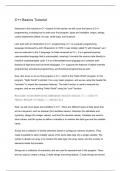Interview
C++ Basics
- Cours
- Établissement
This document provides a brief introduction to the basic concepts of C++, a popular programming language used for a wide range of applications, including operating systems, video games, and high-performance scientific computing. The document covers the following topics: Data Types and Variabl...
[Montrer plus]



